
About UsThe Numismatic Bibliomania Society is a non-profit organization promoting numismatic literature. For more information please see our web site at coinbooks.org SubscriptionsThose wishing to become new E-Sylum subscribers (or wishing to Unsubscribe) can go to the following web page link MembershipThere is a membership application available on the web site Membership Application To join, print the application and return it with your check to the address printed on the application. Membership is only $15 to addresses in the U.S., $20 for First Class mail, and $25 elsewhere. For those without web access, write to: David M. Sundman, Secretary/TreasurerNumismatic Bibliomania
Society AsylumFor Asylum mailing address changes and other membership questions, contact David at this email address: dsundman@LittletonCoin.com SubmissionsTo submit items for publication in The E-Sylum, just Reply to this message, or write to the Editor at this address: whomren@coinlibrary.com
BUY THE BOOK BEFORE THE COINYou won't regret it! |
- WAYNE'S WORDS: THE E-SYLUM JUNE 28, 2009
- SAVILLE ACQUIRES LARGE NUMISMATIC LIBRARY
- LAKE BOOKS SALE #99 CATALOG AVAILABLE
- SKLOW TO AUCTION Q. DAVID BOWERS SOURCE MATERIAL LIBRARIES
- BEN KEELE ON DIGITAL NUMISMATIC LITERATURE
- BEN WEISS EXHIBITS MEDALS AT THE PHILADELPHIA MUSEUM OF ART
- AUDIO SLIDESHOW: MEDALS OF DISHONOUR
- NEWSPAPER PROFILES COIN DESIGNER VICTOR DAVID BRENNER
- SUBSCRIBER PROFILE: P K SAHA, ULTRA MODERN NUMISMATIST
- NEW LATVIAN COIN FEATURES NAMEJS RING
- QUERY: JAMES D. FOSKETT, FIRST ANS LIBRARIAN
- VOCABULARY WORDS: WHAT DO YOU CALL A COIN OR MEDAL ARTIST?
- VOCABULARY WORD: FUTE, REFUTE, AND FUTE AGAIN
- MORE ON U.S. COIN DENOMINATIONS
- MICHAEL MAROTTA ON THE WIZARD OF OZ PARABLE
- FROSSARD LIST: S.M. CLARK FRACTIONAL SPECIMEN COLLECTION
- NUMISMATIC SOCIETY OF AUCKLAND TEUTENBERG MEDAL MINTAGES
- THE OPTICAL TELEGRAPH
- NOTES FROM JOE BOLING ON COUNTERFEITS
- DO FAKES ON EBAY SAVE ANTIQUITIES?
- RARE WATERLOO MEDAL TO BE SOLD FOR CHARITY
- CREATIVE USES FOR ZIMBABWE BANKNOTES
- LINES FORM AT BANKS FOR NEW 50,000-WON BILL
- FEATURED WEB SITE: SYLLOGE NUMMORUM GRAECORUM
WAYNE'S WORDS: THE E-SYLUM JUNE 28, 2009
 Among our recent subscribers is P K Saha. We now have 1,233 subscribers.
Among our recent subscribers is P K Saha. We now have 1,233 subscribers. This week we open with updates from three numismatic literature dealers on two continents. Next, it's Ben and Ben (Keele and Weiss) on digital numismatic literature and a new medal exhibit at the Philadelphia Museum of Art.
Other topics include a profiles of Victor David Brenner and our newest subscriber, more on vocabulary words, U.S. coin denominations and Teutenberg medals. Still other topics cover the Wizard of Oz parable, S. M. Clark's collection of fractional currency specimens, and creative uses for Zimbabwe banknotes. Please don't flush them down the toilet!
To learn about the numismatic work of artists Ilze Libiete and Viktoras Barnauskas, read on. Have a great week, everyone!
Wayne Homren
Numismatic Bibliomania Society
SAVILLE ACQUIRES LARGE NUMISMATIC LIBRARY

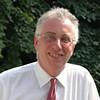 The latest acquisition will take some time for me to put up onto my site - meanwhile if any reader has any specific "want" I would ask them to email me "desiderata". I regret to say that there are no items relating to American numismatics.
The latest acquisition will take some time for me to put up onto my site - meanwhile if any reader has any specific "want" I would ask them to email me "desiderata". I regret to say that there are no items relating to American numismatics. In the main the library includes books relating to many aspects of Ancients, European, British, and world coinages. I have many individual volumes of the Numismatic Chronicle from 1877 to date, but there are few complete runs of the Series.
My website: www.douglassaville.com Email address: info@douglassaville.com
LAKE BOOKS SALE #99 CATALOG AVAILABLE
 The 99th mail-bid sale of numismatic literature from Lake Books is now available for viewing on our web site at www.lakebooks.com/current.html .
The 99th mail-bid sale of numismatic literature from Lake Books is now available for viewing on our web site at www.lakebooks.com/current.html .The sale is Part Two of selections from the library of Valerie Renee Nickles and features many books that appear in Len Augsburger's compilation of "The 100 Greatest Numismatic Books". The sale contains 403 lots and closes on Tuesday, July 28, 2009 at 5:00 PM (EDT). Bids may be placed via email, fax, telephone or US Mail until that time.
Lake Books
6822 22nd Ave N.
St. Petersburg, FL 33710
(727) 343-8055 FAX:(727) 345-3750
SKLOW TO AUCTION Q. DAVID BOWERS SOURCE MATERIAL LIBRARIES
 We are excited to announce the consignment by renowned author and numismatist, "The Master of Wolfeboro" Q. David Bowers, of his extensive libraries of source material: to include, limited edition works; The California Gold rush 1848-1850's; Comprehensive library of Civil War history; library of American Maritime history, Pirates, Treasure hunting, the era of Sailing and Steam Ships; vast runs and individual copies of historical reference materials, studies, dictionaries, encyclopedias, collected papers and much more; in addition, many works on numismatics, including limited editions, papers, periodicals, journals.
We are excited to announce the consignment by renowned author and numismatist, "The Master of Wolfeboro" Q. David Bowers, of his extensive libraries of source material: to include, limited edition works; The California Gold rush 1848-1850's; Comprehensive library of Civil War history; library of American Maritime history, Pirates, Treasure hunting, the era of Sailing and Steam Ships; vast runs and individual copies of historical reference materials, studies, dictionaries, encyclopedias, collected papers and much more; in addition, many works on numismatics, including limited editions, papers, periodicals, journals. The sale of this vast collection (numbering in the thousands of volumes) will take place in multiple parts; Part I-February 2010; Part II-June 2010 and Part III-October 2010; all volumes will bear the special small format bookplate of the Q. David Bowers research Library.
Imagine, the library used by the most prolific numismatic writer of the past fifty years! Be sure not to miss this opportunity to own a piece of numismatic history from the library of a numismatic legend! Catalogs are sent upon request.
The Q. David Bowers library sales will occupy approximately 50% of each catalog.
Contact: David Sklow-Fine Numismatic Books
P.O. Box 6321
Colorado Springs, CO 80934
PH (719)-302-5686
FAX (719) 302-4933
numismaticbooks@aol.com
www.finenumismaticbooks.com
THE BOOK BAZARRE
BEN KEELE ON DIGITAL NUMISMATIC LITERATURE
Ben Keele writes:Toward Digital Numismatic Literature
Benjamin Keele
Despite numerous prognostications, the book is not dead. However, the range of forms numismatic literature can take has certainly expanded. Knowledge that once could only be easily transmitted in paper books or journals is now embodied (to use the term loosely) in digital texts, datasets, and audio and video recordings. The increasing volume of numismatic information produced, both hardcopy and digital, raises important questions about how we can preservation this material and pass it on to future generations of enthusiasts and scholars.
Unlike paper books, storing digital files on sturdy shelves in a cool, dark room is not going to do the trick. My aim here is to continue and expand upon the numismatic community’s conversation about the implications of digital publishing for the hobby, particularly those relating to how the community can responsibly maintain long-term and sustainable access to numismatic literature. Some aspects of this question are quite technical, such as archival file format standards, digital media degradation, and file authentication. These are important, to be sure, but I think solutions will be devised once we clarify and reach some agreement on social and policy questions, two of which I will discuss: why is digital preservation important and who should be responsible for it?
The point is that if we do not take sufficient precautions, numismatists twenty, fifty, or one hundred years from now will have significant problems accessing the digital materials we are now producing. While it is true that not every file must be preserved forever, surely some material is worth keeping. Copies of electronic newsletters, like the E-Sylum and other club publications, could be used to show how the hobby adapted to the emergence of the Internet, not to mention contents that were not published elsewhere.
Digital copies of printed books would prevent tomes with small print runs from falling into obscurity. With digital versions of catalogs like the Redbook and Standard Catalog of World Coins, scholars could use computers to trace market patterns and combine information into every more complete and accurate databases. If one wants to research the activities of famous dealers of the early twentieth-century, one looks to print advertisements, price lists, and paper correspondence. Researchers of the future will want to look at websites and email. The potential benefit digital research can offer to numismatists is great, but we limit that potential if we do not keep the basic resources.
To read the complete draft, see: Toward Digital Numismatic Scholarship Preprint (http://www.scribd.com/doc/16729272/Toward-Digital
-Numismatic-Scholarship-Preprint.)
BEN WEISS EXHIBITS MEDALS AT THE PHILADELPHIA MUSEUM OF ART
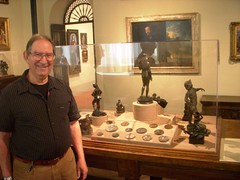 A group of medals from the Collection of Benjamin Weiss has been put on display at the Philadelphia Museum of Art, Philadelphia, Pennsylvania. The display consists of 16th and 17th century medals from Italy, France, Germany and The Netherlands. The medals may be found in the Gallery of Early European Art.
A group of medals from the Collection of Benjamin Weiss has been put on display at the Philadelphia Museum of Art, Philadelphia, Pennsylvania. The display consists of 16th and 17th century medals from Italy, France, Germany and The Netherlands. The medals may be found in the Gallery of Early European Art. The display is a part of Ben's larger collection of Historical and Commemorative Medals.
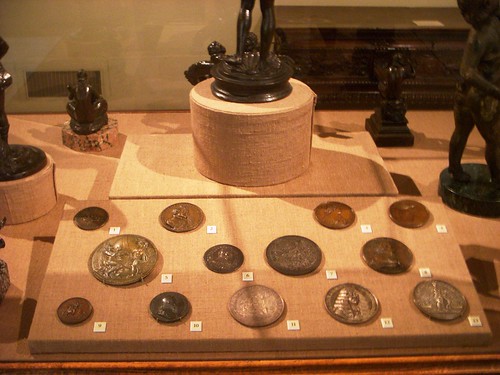
For more information on Ben's collection, see: HISTORICAL AND COMMEMORATIVE MEDALS (www.historicalartmedals.com)
AUDIO SLIDESHOW: MEDALS OF DISHONOUR
The British Museum is hosting an exhibition that looks at how this less well-known tradition has developed over the past 400 years - and also features special commissions from current artists.
Evan Davis was shown around by the co-curators, Philip Attwood and Felicity Powell.
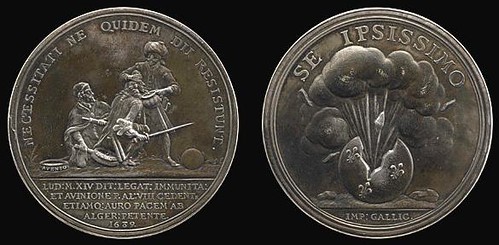
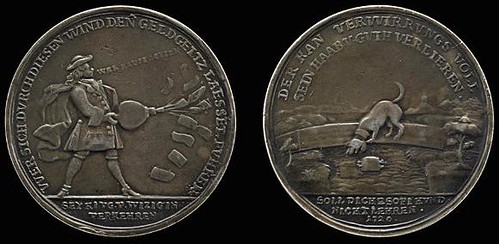
To view the slide show, see: Audio slideshow: Medals of Dishonour (news.bbc.co.uk/today/hi/today/newsid_8117000/8117408.stm)
NEWSPAPER PROFILES COIN DESIGNER VICTOR DAVID BRENNER
Coincidentally, just before discovering this article I was corresponding with Dick Johnson about Brenner works in Pittsburgh and dug out images for him. Included below is an image of the fountain, a magnificent sculpture. -Editor
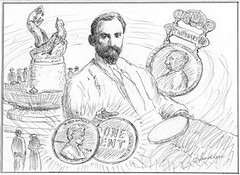 The obstacles sculptor and medalist, Victor David Brenner, had to overcome to see his design for the Lincoln penny — finally minted in 1909 — were minor compared to challenges he faced in his native Lithuania before emigrating to America.
The obstacles sculptor and medalist, Victor David Brenner, had to overcome to see his design for the Lincoln penny — finally minted in 1909 — were minor compared to challenges he faced in his native Lithuania before emigrating to America.Near the end of his career, Clara Whiteside, wife of well known artist Frank Reed Whiteside, interviewed Victor Brenner at his Ogunquit studio overlooking Perkins Cove.
He had been born Viktoras Barnauskas in Shavli, Lithuania, in 1871. At the age of 13 he began an apprenticeship in his father's metal shop and quickly displayed a precocious gift for engraving. At the tender age of 16 he went into business for himself.
Victor arrived in New York in 1890 with no knowledge of the English language, but his superior engraving skills quickly earned him a comfortable living. After eight years, he felt creatively unsatisfied by the work. "I gave in to the discontent that was troubling me — threw up my work and sailed for Paris," he told Clara. There he studied with accomplished medalist, Louis Oscar Roty, and entered Academie Julian. Upon his return to New York, his artistic talents were recognized by well-placed numismatists who encouraged his concentration on commemorative medals.
Brenner's proposed design for the Panama Canal service medal was selected by President Theodore Roosevelt, whose flattering likeness was to be depicted thereon. While the President posed for the artist, the two men developed a comfortable rapport, so much so that Victor felt within the bounds of propriety to suggest that the Indian head on the United States penny be replaced by his sculpture of President Abraham Lincoln.
Roosevelt was persuaded, much to the chagrin of the Chief Engraver at the U.S. Mint, Charles E. Barber, who tried every unctuous trick in the book to discredit Brenner and the quality of his work. Nonetheless, a Victor David Brenner design for the new coin was finally approved by the President and the Secretary of the Treasury.
Victor David Brenner's initials were re-introduced on the front of the Lincoln penny in 1918 just after Charles E. Barber retired from the U.S. Mint.
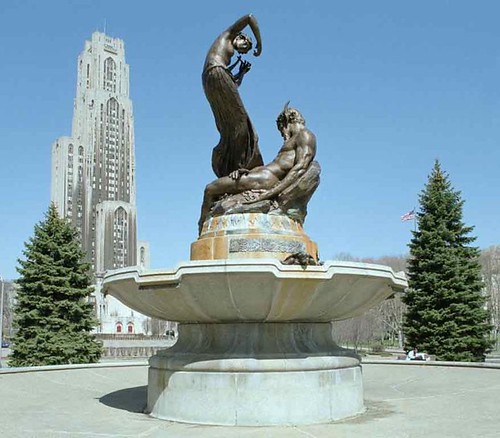
During the same year what could arguably be described as Brenner's masterwork — the Mary Schenley Memorial Fountain, also known as A Song to Nature — was unveiled at the entrance to Schenley Park in Pittsburgh, Pa. The magnificent 30-foot public sculpture in bronze and granite portrays a reclining Pan being serenaded by a graceful female companion. Carla Whiteside's enlightening article was widely published in 1920, but it did not reveal the circumstances that led to Brenner's departure from the motherland. Numismatic expert, David W. Lange, uncovered the particulars in his 2005 book, "The Complete Guide to Lincoln Cents."
Victoras Barnauskas' work so exceeded that of his rival engravers in Lithuania that they resented the number of commissions the teenager took from them. He was accused of counterfeiting. The police, frustrated in trying to obtain evidence of the crime that had never occurred, came into his shop and asked him to duplicate an official seal. Unaware that it was illegal to do so, young Viktor made a perfect copy and was thrown into jail. With the help of some friends he managed to escape and fled to the United States.
To read the complete article, see: The Lincoln penny designed by Ogunquit artist (www.seacoastonline.com/articles/20090625-LIFE-906250372)
SUBSCRIBER PROFILE: P K SAHA, ULTRA MODERN NUMISMATIST
One of the coins posted recently is the Falkland Islands Crown commemorating the Charles Darwin bicentenary (pictured below).
P K Saha writes:
Since I collect this information, I find it little more work to help my friends with similar interests, so I give this information to the COINS list and some others too, like www.worldcoinnews.blogspot.com etc.
I am approved contributor to SCWC 2001- till date. And despite my .uk email address, I do not live in the UK - I live in India.
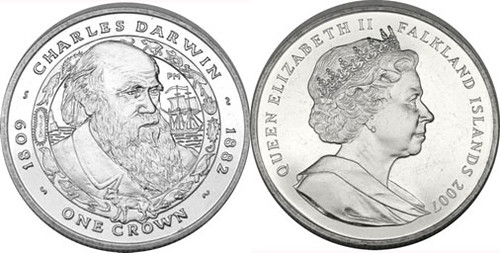
NEW LATVIAN COIN FEATURES NAMEJS RING
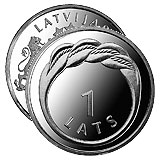 A new 1-lat coin depicting the traditional Namejs ring (Nameja gredzens), often viewed as a symbol of one’s ethnicty, has been put into circulation by the Bank of Latvia.
A new 1-lat coin depicting the traditional Namejs ring (Nameja gredzens), often viewed as a symbol of one’s ethnicty, has been put into circulation by the Bank of Latvia.The coin, made of a copper-nickel alloy, is part of a series of 1-lat coins that have depicted various signs, images and events important to Latvian culture.
The braided ring depicted on the reverse of the new coin is a design that goes back centuries, according to a June 8 press release from the Bank of Latvia.
“This type of ring was named after the Semigallian chieftain Namejs only in the 1930s when two such rings were found in the Daugmale castle mound and they became favorites for replication and wearing,” according to the press release.
Today, the ring “has come to signify that the wearer has some relationship to Latvia: even if he or she belongs to a different nation, it is evidence that they have some connection with the Latvian land or culture,” according to the press release.
The obverse of the coin displays the coat of arms of Latvia.
The coin was designed by Ilze Libiete and the plaster model was made by Baiba Sime, both of whom are marking their debut in coin design. The coin was minted by Staatliche Münze Berlin in Germany.
A total of 1 million of the new coins were minted, according to the Bank of Latvia.
To read the original article, see: New 1-lat coin features Namejs ring (http://latviansonline.com/news/article/5633/)
QUERY: JAMES D. FOSKETT, FIRST ANS LIBRARIAN
Last week we mentioned James D. Foskett, the first librarian of the American Numismatic Society, noting that very little is known of him today. ANS Archivist Joe Ciccone writes:His contributions to the ANS Library are actually a good bit less than one might guess. Although he technically was Librarian from 1858 through 1864, after 1860 the ANS did not meet again until 1864. And when they did regroup early in 1864, Foskett was a no-show. The first person to make substantial contributions to the ANS Library really was Isaac Wood, who served as Librarian from 1869-1880. I've been able to collect some biographical information on him, but what I'm really dying for is a photo, if anyone has one.
Joe adds:
THE BOOK BAZARRE
VOCABULARY WORDS: WHAT DO YOU CALL A COIN OR MEDAL ARTIST?
The term has changed over the years. The dies to strike coins were hand engraved since 600 B.C. Prior to that the dies were crude punches. When images of animals, as a lion or goat, where shown on ancient coins it required an "engraver," a person to carve a negative image -- by hand -- in a piece of iron. He was a "hand engraver" but he was also called a "celator," a carver of glyptic objects.
Hand engraving of dies continued for the next 2000 years. It still exists. Simple dies can still be hand engraved today. So "hand engraver" was the answer for this long period.
Wood blocks were engraved in China and impressions were made of these, but it was Gutenberg's invention of printing with metal type in 1446 that engraving of metal plates for printing began. Such plates for printing maps, prints, illustrations, even paper money required engravers to prepare printers' plates. This form of "flat engraving" or "surface engraving" far surpassed the quantity of modulated engraving of dies, but they were all called "engravers."
To distinguish the engravers of dies, however, from the engravers of printing plates, they were called "diesinkers." I have researched American coin and medal engravers in 19th century directories and I had to search both categories and analyze which type of engraving the "engraver" did. I also learned there were "die forgers" -- these were craftsmen (somewhat like blacksmiths) that tempered the diestocks before the engraving occurred. Obviously these were not engravers (but their initials were occasionally found on the sides of dies).
Then along came the die-engraving pantograph, a machine that revolutionized coin and medal making. Mints and medal makers required oversize coin and medal patterns. These were created by "sculptors" creating bas-relief models in plaster. But for sixty years these sculptors would only create a relief model of the device only, not the entire side. By the end of the 19th century, literally 1899, Victor Janvier patented his die-engraving pantograph that was so exacting a sculptor could model the device, lettering, border elements, everything! - for each side of a coin or medal on one bas-relief plaster model.
So it was "sculptors" who became coin and medal artists. However, even at the mints around the world this person was still called an "engraver" and the person in charge of that department was called a "chief engraver." If you read the job description for a U.S. Mint engraver, however, it spells out the requirement of modeling the sculptural models.
So "sculptor" it is. But if it is a female do not call her a "sculptress." Long before political correctness occurred, with even such a famous person as Malvina Hoffman (she created models for medals and included a chapter on creating coin and medal models in her book Sculpture Inside and Out) she preferred equal billing with men. "Call me a sculptor" she insisted.
Now if you were expecting a joke after reading that headline here it is. What do you call a two hundred million-year-old Pig?
Answer: Jurassic pork!
PS: To learn more about the term "Celator" click on: Celator, Caelator, or Signator: What was a Roman Die-Engraver Called? (http://coinarchaeology.blogspot.com/2009/01/
celator-caelator-or-signator-what-was.html)
VOCABULARY WORD: FUTE, REFUTE, AND FUTE AGAIN
The online Merriam-Webster dictionary has these definitions for refute:
2 : to deny the truth or accuracy of refuted the allegations
I then wrote:
1) Dictionaries, esp. modern, are descriptive, not proscriptive. So, poor usage will be reported. That does not make it "technically correct," whatever you may mean by that.
2) The simple gloss you give doesn't show any change of usage, or show what level of speech is reflected. Is this a traditional use, found in good authors? Or is it some corrupt form? We don't know from that citation.
3) OED and Merriam-Webster's 2nd: neither knows the refute = deny usage. Refute traditionally means very strongly to disprove or overthrow by argument. Given its etymology and its past, "refute" entails presentation of compelling evidence.
4) OED supplement (the 4-vol published supplement) has a new meaning, #5 vb transitive: "Sometimes used erroneously to mean 'deny, repudiate'." The earliest use is 1964, where it says that its use on the BBC shocks strict users, i.e., it's known, but clearly as inferior. Perhaps post-war? Other citations are from '78, '79, '80 (about as late as OEDS would get). "Erroneously," it says, i.e., clearly used by people not thinking clearly about what they needed to say, and just wanting the stronger-sounding word, regardless of its meaning.
So, while "refute = deny" may have some currency, it is clearly substandard usage, to be avoided and corrected. Just because it may be "English" doesn't mean it's good English. There are good reasons why it's bad English.
I'm glad Arthur set us straight on this; just as he, George and I thought, the reporter (and the editor who let it slip) were being shoddy with the English language; so far, no one has refuted anything.
-Editor
To read the earlier E-Sylum article, see: VOCABULARY WORD: REFUTE (www.coinbooks.org/esylum_v12n25a13.html)
MORE ON U.S. COIN DENOMINATIONS
Last week, David Gladfelter wrote:For the sake of accuracy, please find a list of the United States coins and the correct dates of appearance of a listed denomination on each type that follows:
Half cent – 1793 – 1797, Denomination stated on the edge of the coin (TWO HUNDRED FOR A DOLLAR), also on the reverse from 1793 – 1857 (HALF CENT), and on the reverse as a fraction from 1793 – 1808 (1/200).
Large cent – 1793 – 1795, Denomination stated on the edge of the coin (ONE HUNDRED FOR A DOLLAR), also on the reverse from 1793 – 1857 (ONE CENT), and on the reverse as a fraction from 1793 – 1807 (1/100).
Half Dime – Denomination stated on the reverse of the 1792 pattern only (Half Disme). Denomination stated on the reverse starting in 1829 (5 C. ).
Dime – Denomination stated on the reverse of the 1792 patterns only (Disme), denomination stated on the reverse starting in 1809 (10 C. ).
Quarter Dollar – First struck in 1796, denomination added to the reverse in 1804 (25 C. ).
Half Dollar – Denomination stated on the edge of the coin from 1794 – 1807 (FIFTY CENTS OR HALF A DOLLAR), also on the reverse in 1796 & 1797 (1/2). Dollar – Denomination stated on the edge of the coin from 1794 – 1803 (ONE HUNDRED CENTS ONE DOLLAR OR UNIT).
Quarter Eagle – Denomination stated on the reverse starting in 1808 (2 ½ D. ).
Half Eagle - Denomination stated on the reverse starting in 1807 (5 D. ).
Eagle - Denomination stated on the reverse starting in 1838 (TEN D. ).
In my opinion, the new larger silver coins (half dollar & dollar) had a denomination stated to establish their value, where as, it was felt that the smaller denominations would be easily identifiable due to their size in relationship to the larger coins.
It was also thought that the value of the gold pieces were easily determined by comparison to the sizes of other foreign coins in circulation at the time, as well as the ability by most merchants to check their weights. Most likely due to the fact that these ideas did not work that well, easily seen and understood denominations were eventually stated on every circulating coin type.
MICHAEL MAROTTA ON THE WIZARD OF OZ PARABLE
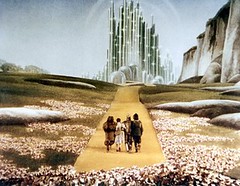 The theory that The Wonderful Wizard of Oz is a “parable about populism” originated with Henry M. Littlefield. “The Wizard of Oz: Parable on Populism.” American Quarterly, Vol. 16, No. 1 (Spring, 1964, pp. 47-58. Johns Hopkins University Press).
The theory that The Wonderful Wizard of Oz is a “parable about populism” originated with Henry M. Littlefield. “The Wizard of Oz: Parable on Populism.” American Quarterly, Vol. 16, No. 1 (Spring, 1964, pp. 47-58. Johns Hopkins University Press). Littlefield was the first to explicitly identify the Scarecrow as the Farmer, the Tinman as the Industrial Worker, the Cowardly Lion as William Jennings Bryan, the Wizard “might be any President from Grant to McKinley.” In the original story, Dorothy is given silver, not ruby slippers. The Yellow Brick Road is the gold standard.
In retelling the theory 25 years later, political science professor Michael A. Genovese wrote: “The allegory begins with the title. Oz is the abbreviation for ounce, the standard measure used for gold.” In 1989, economics professors Michael Watts and Robert F. Smith pointed out that oz stands for an ounce of both silver and gold.
According to economics professor Hugh Rockoff: “The cyclone is the free silver movement itself. It came roaring out of the West in 1896, shaking the political establishment to its foundations.” In 1991, Mitchell Sanders found meaning in the magical golden cap. “The existence of the magical cap thus represents a twisted version of the Golden Rule: whoever owns the gold makes the rules.” Similar emendations and amendments are in many of the retellings.
Littlefield himself actually published something of a retraction, in the opinion pages of the New York Times for February 7, 1992: “…there is no basis in fact to consider Baum a supporter of turn-of-the-century Populist ideology. … Baum's story may be taken as a parable on Populism, not a Populist parable. …
We will never know if Baum had any conscious allegory in mind. I still think of the possibility of political allusions in “The Wizard of Oz” as a kind of undercurrent, a context. My original point in the article was not to label Baum, or to lessen any of his magic, but rather, as a history teacher at Mount Vernon High School, to invest turn-of-the-century America with the imagery and wonder I have always found in his stories.”
Despite that, the theory has taken on a life of its own. Speculations continue, in part, because the circumstantial evidence is strong. The salient point for numismatists is that the idea did not begin with Walter Breen. In fact, none of the 26 works I have found on this subject cites Breen. Some cite no one, the author taking full credit for the ideas of others.
FROSSARD LIST: S.M. CLARK FRACTIONAL SPECIMEN COLLECTION
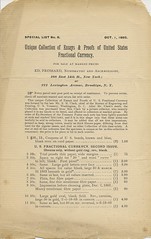 Sometimes it pays to take a second or third look at something in one's collection. At Jerry Fochtman's request I scanned an Ed. Frossard Fixed Price List and emailed him a copy. Jerry's researching U.S. postal and fractional currency, and in my ephemera files I had this fixed price list of fractional currency issued by Ed. Frossard (his Special List No8).
Sometimes it pays to take a second or third look at something in one's collection. At Jerry Fochtman's request I scanned an Ed. Frossard Fixed Price List and emailed him a copy. Jerry's researching U.S. postal and fractional currency, and in my ephemera files I had this fixed price list of fractional currency issued by Ed. Frossard (his Special List No8).Until I scanned it I'd forgotten how special this price list is. Frossard is offering the collection of specimen notes that had been the property of S. M. Clark, head of the Bureau of Engraving and Printing during the period when the currency was issued.
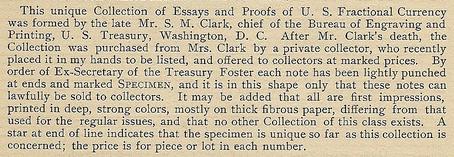
NUMISMATIC SOCIETY OF AUCKLAND TEUTENBERG MEDAL MINTAGES
In the June 7, 2009 E-Sylum article about the new book on engraver Anton Teutenberg, Tone Hine wrote:
Martin Purdy writes:
To read the earlier E-Sylum article, see: BOOK REVIEW: TEUTENBERG: A MASTER ENGRAVER AND HIS WORK (http://www.coinbooks.org/esylum_v12n23a07.html)
THE OPTICAL TELEGRAPH
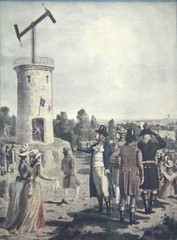 Before the telegraph, there was the optical telegraph, a chain of towers topped by large pivoting cross members, and spaced as far apart as the eye could see. Developed by the Frenchman Claude Chappe at the end of the 18th century, optical telegraph lines once stretched from Paris out to Dunkirk and Strasbourg, and were in service for more than half a century:
Before the telegraph, there was the optical telegraph, a chain of towers topped by large pivoting cross members, and spaced as far apart as the eye could see. Developed by the Frenchman Claude Chappe at the end of the 18th century, optical telegraph lines once stretched from Paris out to Dunkirk and Strasbourg, and were in service for more than half a century:Several optical telegraph relay stations are still around, including one in Saverne, France that was renovated in 1998.
To read the complete article, see: The Chappe Optical Telegraph (www.boingboing.net/2009/06/20/the-chappe-optical-t.html)
NOTES FROM JOE BOLING ON COUNTERFEITS
Regarding various items in last week's E-Sylum, Joe Boling writes:The website on distinguishing counterfeit money fails to note that $5 bills no longer have a portrait in the watermark - they have a large numeral 5 in the watermark window and the words FIVE FIVE FIVE on the other end of the note. This is to force note bleachers to spend more money (at least $10 now) to obtain substrate for their ink-jet $100s.
The linked article on the How Things Work website fails to note that modern image-processing software recognizes security patterns in the designs and shuts down rather than print pictures of notes.
DO FAKES ON EBAY SAVE ANTIQUITIES?
Arthur Shippee writes:Today’s idea: EBay — rather than encourage the looting of antiquities as you might expect — discourages it by fueling a huge global market for cheap fakes, an archeaologist says.
Despite fears that the Internet would democratize antiquities trafficking and lead to widespread plunder, “it appears that electronic buying and selling has actually hurt the antiquities trade,” writes Charles Stanish, a U.C.L.A. professor, in the journal Archaeology.
“People who used to make a few dollars selling a looted artifact to a middleman in their village can now produce their own ‘almost-as-good-as-old’ objects and go directly to a person in a nearby town who has an eBay vendor account,” he explains, speaking from personal field experience. “They will receive the same amount or even more than they could have received for actual antiquities.”
Not only that, since the best forgeries now “can fool even supposed experts like me,” even the high-end market for the real, pillaged McCoy is suffering.
It’s a situation that P.T. Barnum along with preservationists could appreciate. “I suppose if people stopped believing that they can buy a pill that will help them lose weight without dieting or exercise, then it is possible that people will stop buying fakes online, and we will return to old-fashioned looting,” Stanish sighs in conclusion.
To read the complete article, see: How Fakes on eBay Save Antiquities (ideas.blogs.nytimes.com/2009/06/24/how-fakes
-on-ebay-save-antiquities/)
RARE WATERLOO MEDAL TO BE SOLD FOR CHARITY
The rare Waterloo medal has been in George Draffen’s family for more than 180 years.
It was presented to his ancestor Sergeant James Draffen, of the 2nd Battalion Grenadier Guards, after the battle in 1815.

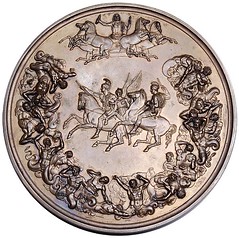
Mr Draffen and his wife Lesley are auctioning the heirloom to raise money for forces charity Help for Heroes.
The award was the first true campaign medal and was issued to all ranks who fought in the battles of Waterloo, Ligny and Quatre Bras.
It is expected to sell for between £2,500 and £3,500 when it goes under the hammer at McTear’s Auctioneers in Glasgow on Saturday.
To read the complete article, see: Rare Waterloo medal to be sold for charity (www.pressandjournal.co.uk/Article.aspx/1276149)
CREATIVE USES FOR ZIMBABWE BANKNOTES
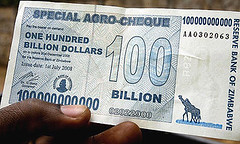 An advertising campaign of billboards made of worthless Zimbabwean banknotes has won an international advertising award, reports in the country said Wednesday. The Zimbabwean, a bi-weekly newspaper published in London but sold in Zimbabwe, pasted together hundreds of banknotes with denominations of up to trillions of the now defunct Zimbabwe dollar to make up the billboards, the newspaper said.
An advertising campaign of billboards made of worthless Zimbabwean banknotes has won an international advertising award, reports in the country said Wednesday. The Zimbabwean, a bi-weekly newspaper published in London but sold in Zimbabwe, pasted together hundreds of banknotes with denominations of up to trillions of the now defunct Zimbabwe dollar to make up the billboards, the newspaper said. 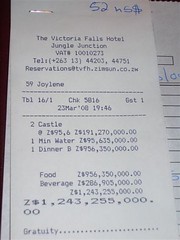 Over the bills were pasted messages that said, "Thanks to (President Robert) Mugabe this money is wallpaper," "It's cheaper to print on this money than on paper," and "Fight the regime that has crippled a country."
Over the bills were pasted messages that said, "Thanks to (President Robert) Mugabe this money is wallpaper," "It's cheaper to print on this money than on paper," and "Fight the regime that has crippled a country."Knocking 25 zeroes off the currency in 18 months failed to stem the slide. The highest-denomination banknote issued in February of 100 trillion Zimbabwe dollars was just enough for a few loaves of bread.
Shoppers had to carry bags full of cash for groceries and signs in public toilets at the border control post with neighbouring South Africa instructed users not to flush Zimbabwe dollars down the toilet.
To read the complete article, see: Billboards made of Zimbabwe dollars bag top advertising prize (www.earthtimes.org/articles/show/274663,billboards
-made-of-zimbabwe-dollars-bag-top-advertising-prize.html)
LINES FORM AT BANKS FOR NEW 50,000-WON BILL
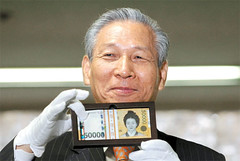 The 50,000-won ($38.91) bill, now Korea’s largest-denominated banknote, entered circulation yesterday amid curiosity and concerns.
The 50,000-won ($38.91) bill, now Korea’s largest-denominated banknote, entered circulation yesterday amid curiosity and concerns.Analysts said the new bill would improve the efficiency of financial transactions while neither boosting the economy nor accelerating inflation significantly.
The Bank of Korea released 1.65 trillion won in the bills yesterday through commercial banks and post offices. Dozens of people stood in line at the BOK’s headquarters in central Seoul before teller windows opened at 9 a.m. yesterday to get their hands on one.
Large branches of major banks such as Kookmin and Shinhan in Myeong-dong and Yeouido, Seoul’s financial centers, were also crowded in the morning with people after the new bill, staff members said.
On the other hand, bank branches in other parts of Seoul were relatively calm. “As people know that the notes of the earliest serial numbers will be put up for auction, they don’t seem to be hurrying to get one,” said a staff member at Hana Bank’s Seocho branch.
“The 50,000-won bill is prettier than I expected,” said Min Ji-hyeon, a 38-year-old housewife, as she emerged from the branch after exchanging her 10,000-won bills for 50,000-won bills. She said she came not just because the new bills were more convenient but also out of curiosity.
“The new bill will make my wallet flatter and lighter and I like it,” she continued. “But I am concerned that due to the existence of the 50,000-won bill, I will feel pressed to pay at least 50,000 won as congratulatory money when I am invited to a wedding.”
To read the complete article, see: Lines form at banks for new 50,000-won bill (http://joongangdaily.joins.com/article/view.asp?aid=2906511)
FEATURED WEB SITE: SYLLOGE NUMMORUM GRAECORUM
This week's Featured Web site is The Sylloge Nummorum Graecorum
The project was inaugurated in 1931 with the publication of the collection of Capt. E.G. Spencer-Churchill. A new and distinctive format was used, with text and illustrations on facing pages. This meant that only limited text was included, with the illustrations having greater prominence than in earlier types of catalogues, and to some extent replacing textual descriptions. This is because the primary purpose of SNG was to make much more material available for study. This format has been retained ever since and has been adopted, along with the title Sylloge Nummorum Graecorum, for similar projects in many other countries, including Denmark, France, Germany, Greece, Israel, Sweden, Switzerland and the United States.
www.sylloge-nummorum-graecorum.org
